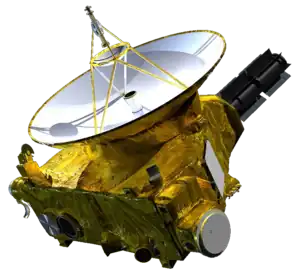| Discovery[1][2] | |
|---|---|
| Discovered by | New Horizons KBO Search |
| Discovery site | Las Campanas Obs. |
| Discovery date | 29 April 2011 (first observed only) |
| Designations | |
| 2011 HM102 | |
| Orbital characteristics[1] | |
| Epoch 4 September 2017 (JD 2458000.5) | |
| Uncertainty parameter 6 | |
| Observation arc | (354 days) |
| Aphelion | 32.778 AU |
| Perihelion | 27.660 AU |
| 30.219 AU | |
| Eccentricity | 0.0847 |
| 166.12 yr (60,675 days) | |
| 33.571° | |
| 0° 0m 21.24s / day | |
| Inclination | 29.348° |
| 100.97° | |
| 151.24° | |
| Physical characteristics | |
| Dimensions | 100 km (est. at 0.10)[4] |
| 8.1[1] | |
2011 HM102 is the ninth Neptune trojan discovered. It was first observed on 29 April 2011, during the New Horizons KBO Search (268) using the Magellan II (Clay) Telescope at Las Campanas Observatory in Chile.[2][5] It has the same orbital period as Neptune and orbits at the L5 Lagrangian point about 60° backwards of Neptune.[3]
Orbit and classification
Neptune trojans are resonant trans-Neptunian objects (TNO) in a 1:1 mean-motion orbital resonance with Neptune. These Trojans have a semi-major axis (a) very similar Neptune's (30.10 AU).
2011 HM102 orbits the Sun with a semi-major axis of 30.219 AU at a distance of 27.7–32.8 AU once every 166 years and 1 month (60,675 days). Its orbit has an eccentricity of 0.08 and an inclination of 29° with respect to the ecliptic.[1] Among the first 17 Neptune trojans discovered so far, it is the one with the highest inclination.[3]
Physical properties
Diameter and albedo
Based on a generic magnitude-to-diameter conversion, it measures approximately 100 kilometers in diameter using an absolute magnitude of 8.1 and an assumed albedo of 0.10.[4] It is an averaged-sized body among the first 17 Neptune trojans discovered so far, which measure between 60 and 200 kilometers (for an absolute magnitude of 9.3–6.6 and an assumed albedo of 0.10).[3][4]
Surface
Observations with NIRSpec showed that the spectrum of 2011 HM102 does not exhibit clear Triton-like ice tholin features. The surface is likely covered in a thin layer of water ice and CO2 ice. Due to the variable color classification of this object, it is suspected that inhomogeneities in the surface composition exist.[6]
Numbering and naming
Due to its orbital uncertainty, this minor planet has not been numbered and its official discoverers have not been determined.[1][2] If named, it will follow the naming scheme already established with 385571 Otrera, which is to name these objects after figures related to the Amazons, an all-female warrior tribe that fought in the Trojan War on the side of the Trojans against the Greek.[7]
Exploration
In October 2012, 2011 HM102 was the closest known object of any kind to the New Horizons spacecraft.[8] In mid- to late 2013, New Horizons passed within 1.2 AU of 2011 HM102, where it would be detectable with one of the onboard instruments.[5] An observation from New Horizons would measure the phase curve of 2011 HM102 at phase angles unobtainable from Earth. The New Horizons team eventually decided that they would not target 2011 HM102 for observations because the preparations for the Pluto approach took precedence.[9]
See also
References
- 1 2 3 4 5 6 "JPL Small-Body Database Browser: (2011 HM102)" (2012-04-17 last obs.). Jet Propulsion Laboratory. Retrieved 4 August 2017.
- 1 2 3 4 "2011 HM102". Minor Planet Center. Retrieved 4 August 2017.
- 1 2 3 4 "List Of Neptune Trojans". Minor Planet Center. 10 July 2017. Retrieved 4 August 2017.
- 1 2 3 "Asteroid Size Estimator". CNEOS/JPL. Retrieved 4 August 2017.
- 1 2 Parker, Alex H.; Buie, Marc W.; Osip, David J.; Gwyn, Stephen D. J.; Holman, Matthew J.; Borncamp, David M.; et al. (April 2013). "2011 HM102: Discovery of a High-inclination L5 Neptune Trojan in the Search for a Post-Pluto New Horizons Target". The Astronomical Journal. 145 (4): 96, 6 pp. arXiv:1210.4549v2. Bibcode:2013AJ....145...96P. doi:10.1088/0004-6256/145/4/96. S2CID 119267735. Retrieved 4 August 2017.
- ↑ Markwardt, Larissa; Holler, Bryan J.; Lin, Hsing Wen; Gerdes, David W.; Adams, Fred C.; Malhotra, Renu; Napier, Kevin J. (6 October 2023). "First Near-IR Spectroscopic Survey of Neptune Trojans with JWST: Distinct Surface Compositions of Red vs Ultra-Red Neptune Trojans". ApJL: 10. arXiv:2310.03998.
- ↑ Ticha, J.; et al. (10 April 2018). "DIVISION F / Working Group for Small Body Nomenclature Working Group for Small Body Nomenclature. THE TRIENNIAL REPORT (2015 Sept 1 - 2018 Feb 15)" (PDF). IAU. Retrieved 25 August 2018.
- ↑ Alex Parker (9 October 2012). "Citizen "Ice Hunters" help find a Neptune Trojan target for New Horizons". The Planetary Society. Retrieved 4 August 2017.
- ↑ Alex Parker (30 April 2013). "2011 HM102: A new companion for Neptune". The Planetary Society. Retrieved 4 August 2017.
External links
- A. Parker – 2011 HM102: A new companion for Neptune – TPS
- MPEC 2012-T05 : 2011 HM102
- YouTube video showing the orbital evolution
- Discoverer comments
- AstDyS-2 about 2011 HM102
- 2011 HM102 at AstDyS-2, Asteroids—Dynamic Site
- 2011 HM102 at the JPL Small-Body Database
